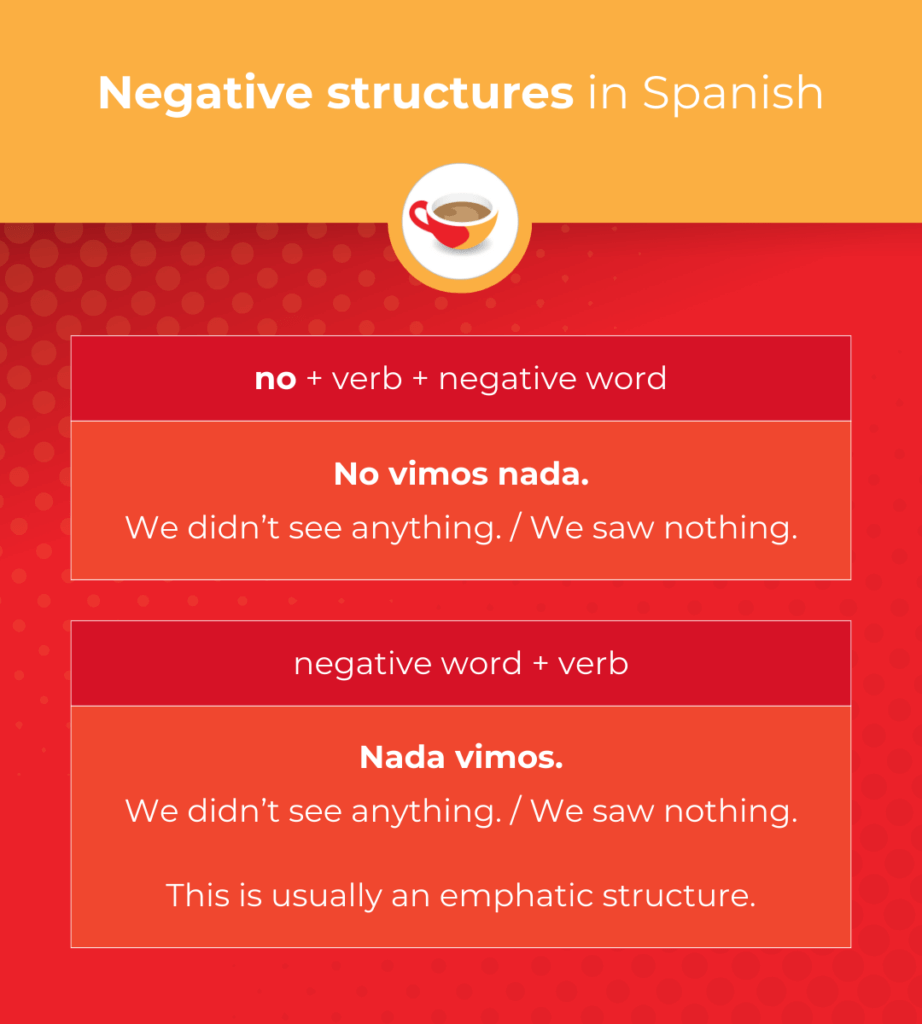Making negative statements in Spanish can be challenging for learners. The negative in Spanish works differently from English which can mean it’s easy to make mistakes.
However, there are some simple rules that can help us correctly use negative structures when we are speaking in Spanish.
The Coffee Break Spanish Show is a podcast series of short, informal conversations to help you understand some difficult topics in Spanish. In the latest episode, Mark and Anabel talk about how to use negatives in Spanish.
We hope that you find this guide to negation useful and we recommend listening along to the podcast or video episode as you read!
Plus, don’t miss our free worksheet at the end to practise what you learn!
How to form a negative statement in Spanish
To turn a positive statement into a negative statement in Spanish, the first rule to know is that we use no before any verb, compound verb, or verb with its pronouns. Let’s look at some examples:
no tengo
I don’t have
no soy escocés
I am not Scottish
no lo sé
I don’t know (it)
no me desperté
I didn’t wake up
It can get a bit more challenging when we add another negative word into the sentence. This is because it creates what we call “double negation”.
In English (in most varieties), we say “I have nothing” or “I don’t have anything”, where only one negative word is possible in the sentence to negate the statement – either “nothing” or “don’t”.
This works differently in Spanish, however. In Spanish, this double negation often appears, when we have two of these negative words to create a negative statement.
Words used to negate in Spanish
We’ve already looked at no (“not”), so let’s now see some other negative words in Spanish:
nunca / jamás
never
nunca jamás
never ever
tampoco
neither
nadie
no one / nobody
ningún / ninguno / ninguna
any
nada
nothing
If we are using one of these words in a statement, we have two options in how to structure the statement:
1. ‘no’ + verb + negative word
For example:
No vimos nada.
We didn’t see anything. / We saw nothing.
No me ha llamado nadie.
No one has called me.
No he desayunado tampoco.
I haven’t had breakfast either.
2. negative word + verb
For example:
Nada vimos.
We didn’t see anything. / We saw nothing.
Nadie me ha llamado.
No one has called me.
Tampoco he desayunado.
I haven’t had breakfast either.
This second construction, where the negative word comes before the verb, creates a more emphatic statement. Let’s use one of our examples in context to see this emphasis:
A: ¿Te han llamado esta tarde?
B: No me ha llamado nadie.
A: Dime la verdad. ¿Te ha llamado Juan? ¿Alberto? ¿Tal vez Clara?
B: No, nadie me ha llamado.
A: Did anyone call you this afternoon?
B: No one has called me.
A: Tell me the truth. Did Juan call you? Alberto? Maybe Clara?
B: No, no one has called me.
To summarise, in Spanish, we must have a negative word before the verb. This is why we may have double negation, in cases where a negative word such as nada or nunca goes after the verb.
A visual summary of making negative statements in Spanish

Let’s practise making negative statements in Spanish
Now it’s your turn to practise the negative in Spanish! Your challenge is to write down the two possible Spanish translations of each of the following sentences.
- I don’t know anything.
- No one buys there.
- No client has it.
You will find the answers at the end of this article, and for a little more practice download the free worksheet below to see how much you’ve learned about making negative statements in Spanish.
Make sure to listen to the full episode with Mark and Anabel on The Coffee Break Spanish Show. This is the series in which we look at a range of topics for Spanish learners, so make sure to subscribe to our podcast feed and our channel on YouTube.
Plus! To get regular free Spanish lessons in your inbox, you can sign up for our short (coffee-break-sized) email lessons that will help you improve your Spanish. You will also hear from Mark, the founder of Coffee Break Languages, giving advice for language learners at any level. Sign up below!
We hope that you now know enough about negation in Spanish to feel positive when you are using your Spanish negatives!
Happy Coffee Breaking!
PS. Here are the answers to the translation challenge.
- I don’t know anything. – No sé nada. / Nada sé.
- No one buys there. – No compra nadie allí. / Nadie compra allí.
- No client has it. – No lo tiene ningún cliente. / Ningún cliente lo tiene.



